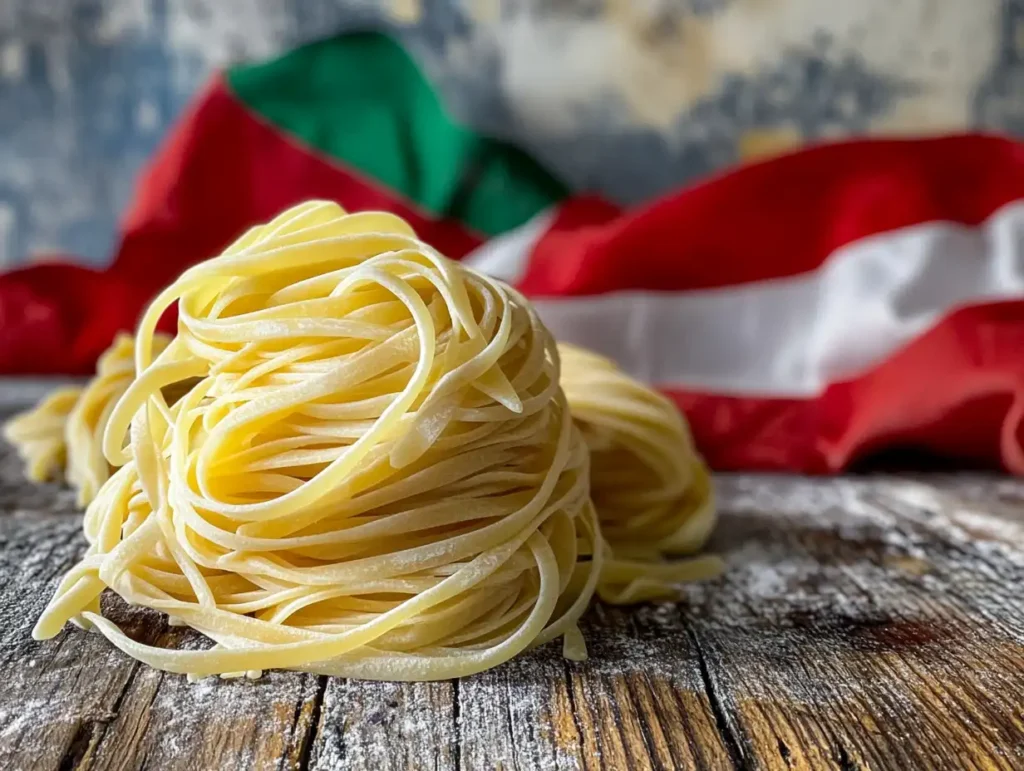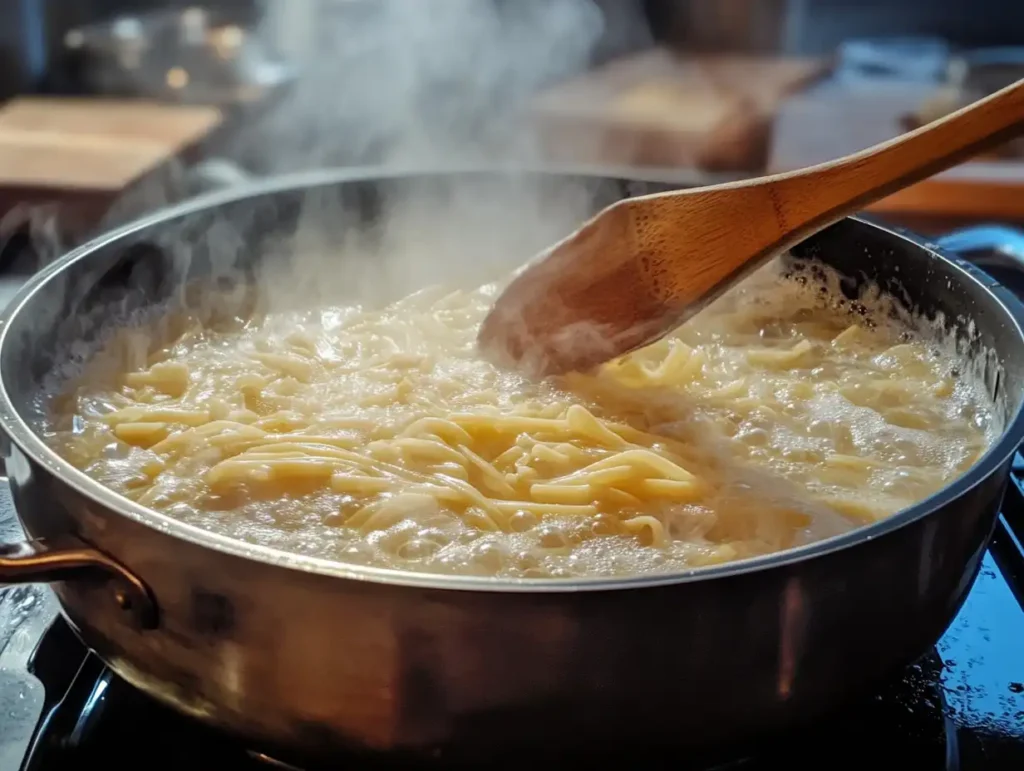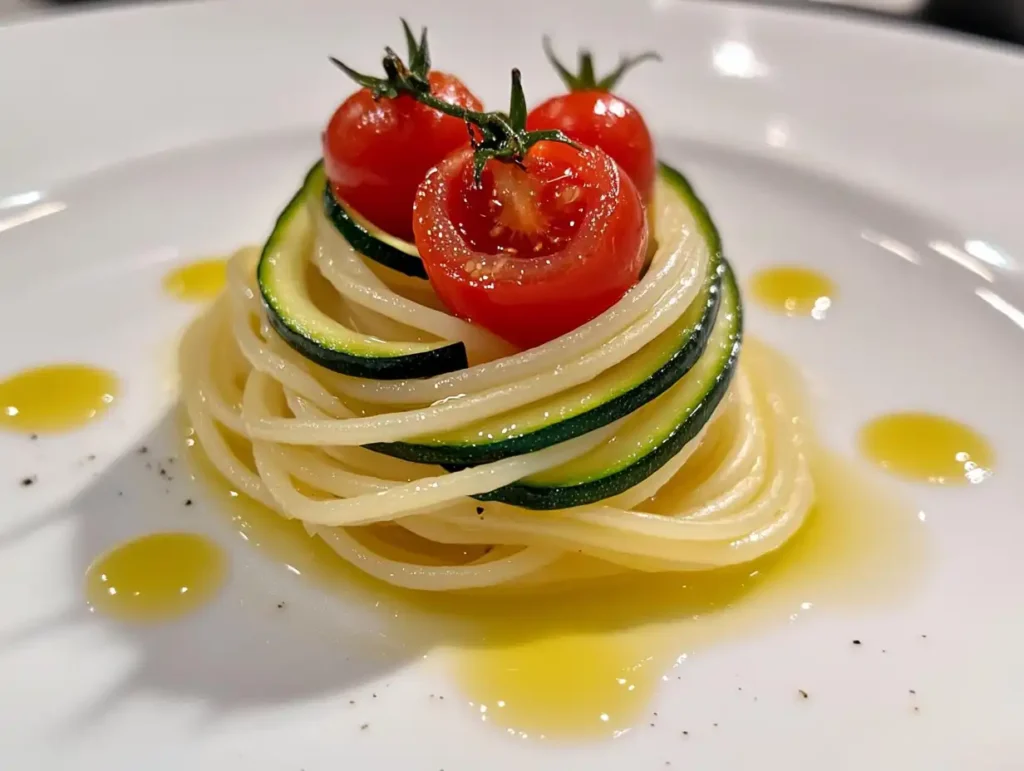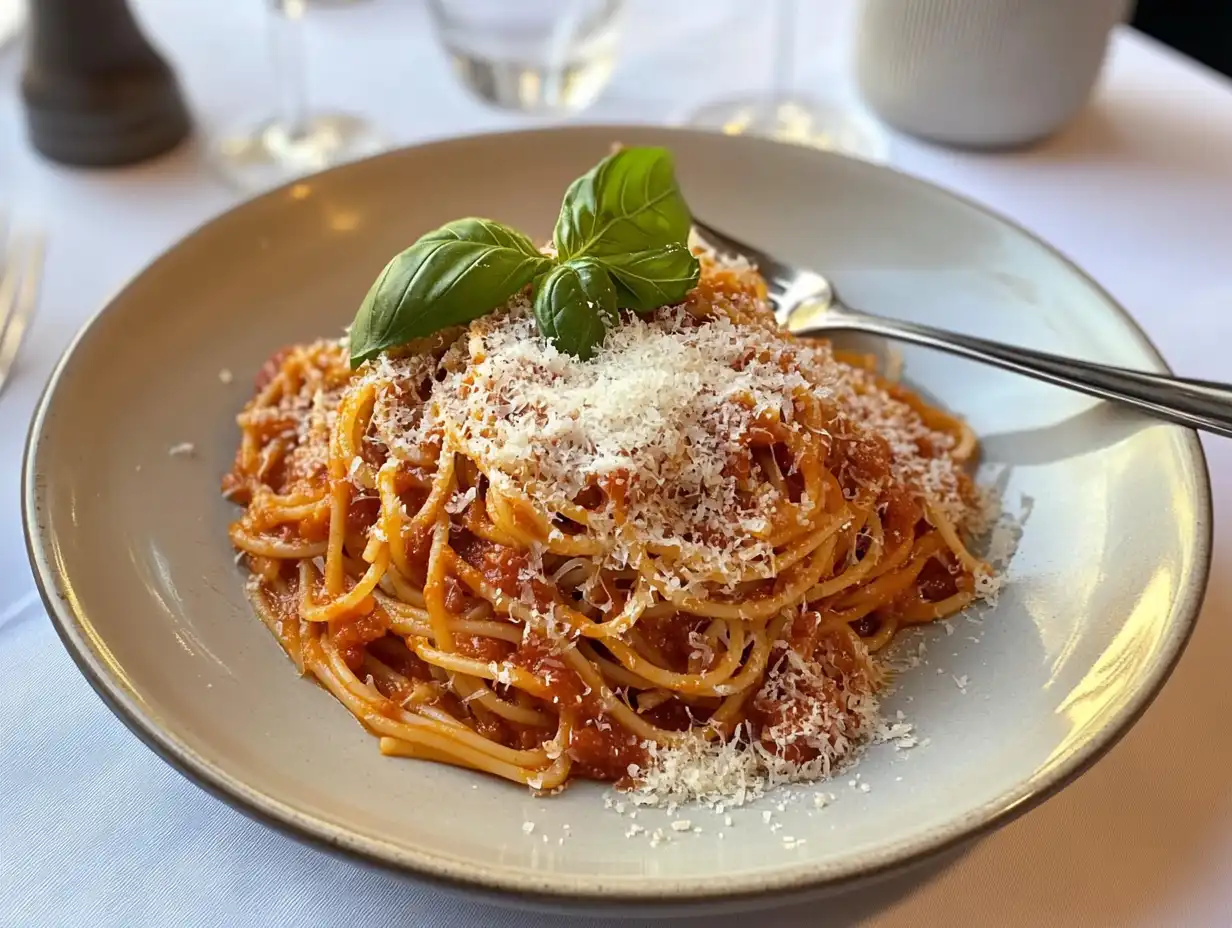Introduction
Capellini d’Angelo, often known as angel hair pasta, is a beloved Italian pasta variety cherished worldwide for its lightness and versatility. But what is Capellini d’Angelo pasta called in other regions or cuisines? In this guide, we’ll explore its alternate names, uses, and cultural significance. Whether you’re preparing it for a quick meal or a gourmet dish, understanding what Capellini d’Angelo pasta is called globally can enrich your culinary journey.
When it comes to Italian cuisine, few pasta types embody elegance and simplicity as effectively as Capellini d’Angelo. Known for its versatility and lightness, it has earned its place in kitchens worldwide. Throughout this guide, we’ll delve into every aspect of Capellini d’Angelo, ensuring you become an expert on this delightful ingredient.
What is Capellini d’Angelo?

Capellini d’Angelo, commonly referred to as “angel hair pasta,” is a variety of Italian pasta celebrated for its ultra-thin strands. The name “Capellini d’Angelo” translates to “angel hair” in English, reflecting its delicate and almost ethereal appearance. This pasta is renowned for its ability to cook quickly and pair beautifully with light sauces, making it a staple in kitchens around the globe.
Characteristics of Capellini d’Angelo
- Thinness and Texture: Capellini d’Angelo is among the thinnest types of pasta, with a diameter typically ranging from 0.85 mm to 0.92 mm. Its fine texture ensures a tender bite and a silky mouthfeel.
- Shape and Form: The long, slender strands resemble fine hair, giving it the “angel hair” moniker.
- Quick Cooking Time: Due to its thinness, Capellini d’Angelo cooks in about 2-3 minutes, making it ideal for quick meals.
Common Uses
Capellini d’Angelo is a versatile pasta that shines in a variety of dishes:
- Light Sauces: It pairs exceptionally well with light, oil-based sauces like aglio e olio or fresh tomato sauces.
- Seafood Dishes: Often combined with shrimp, clams, or crab to create delicate yet flavorful recipes.
- Broths and Soups: Its slender size makes it an excellent addition to clear broths or consommés.
Alternate Names for Capellini d’Angelo
What is Capellini d’Angelo pasta called outside Italy? While “angel hair” is the most common English term, the pasta has several alternate names reflecting its delicate nature. For instance, in Italian-American cuisine, it is often simply referred to as “angel hair.” In traditional Italian contexts, “Capellini” is commonly used, with the full name “Capellini d’Angelo” emphasizing its elegance.
Alternate Names and Translations
- Angel Hair: The English translation, commonly used in American and British kitchens.
- Capellini: A shorter version of the Italian name, often used interchangeably.
- Fidelini: An older term sometimes used in Italy, particularly in traditional recipes.
- Hair Pasta: A colloquial term reflecting its appearance.
Regional Variations
- In Italy, the term “Capellini” is used more broadly, while “d’Angelo” emphasizes the angelic delicacy of the strands.
- In Mediterranean cuisine, variations of this pasta might be referred to as “thin vermicelli” or “vermicellini.”
Understanding these names is essential for recognizing Capellini d’Angelo in different culinary contexts and regions.
History of Capellini d’Angelo
The origins of Capellini d’Angelo are deeply rooted in Italian culinary tradition, where pasta has long been celebrated as an art form. This thin, delicate pasta embodies Italy’s rich gastronomic history and its love for simple, high-quality ingredients.
Origins of the Name
The name “Capellini” derives from the Italian word capello, meaning “hair,” while “d’Angelo” translates to “of the angel.” Together, the phrase evokes a poetic image of delicacy and lightness. This romantic naming reflects the pasta’s appearance and its association with refined, elegant meals.
Early References to Capellini
Historical records suggest that thin pasta like Capellini dates back to the Middle Ages, when Italian cooks began experimenting with various pasta shapes and sizes. In regions like Liguria and Lombardy, where Capellini likely originated, pasta makers sought to create lighter, thinner versions of traditional noodles.
- Renaissance Era: During the Renaissance, pasta gained popularity across Italy, and Capellini became a symbol of culinary sophistication.
- Cultural Significance: Its association with “angel hair” made it a favorite in dishes meant to celebrate special occasions or religious feasts.
Evolution Through Time
Capellini’s thin and fast-cooking nature made it particularly appealing in households where time and resources were scarce. Over the centuries, it evolved from a regional specialty to a globally recognized pasta variety.
- Industrialization: The 19th and 20th centuries saw the industrial production of pasta, bringing Capellini to international markets.
- Modern Popularity: Today, Capellini d’Angelo is celebrated not just for its heritage but also for its versatility and convenience in modern cooking.
How Capellini d’Angelo Is Made
Capellini d’Angelo may look simple, but its creation requires precision and attention to detail. Traditionally crafted from high-quality ingredients, this pasta is a testament to the artistry of Italian cuisine.
Key Ingredients
- Durum Wheat Semolina: The primary ingredient, chosen for its strength and elasticity.
- Water: Used to bind the flour into a smooth dough.
Traditional Preparation Methods
- Mixing and Kneading: The semolina and water are combined and kneaded into a firm, pliable dough.
- Shaping: Using a pasta extruder with fine holes, the dough is shaped into thin strands.
- Drying: The Capellini is dried slowly at low temperatures to preserve its texture and flavor.
Modern Techniques
Today, pasta manufacturers use advanced machinery to produce Capellini d’Angelo in large quantities while maintaining its delicate characteristics. Despite modernization, many Italian artisans continue to produce it by hand, honoring traditional methods.
Cooking Techniques for Capellini d’Angelo
Capellini d’Angelo’s delicate nature requires careful preparation to achieve the perfect texture and flavor. Its quick cooking time makes it ideal for fast meals, but overcooking or pairing it with heavy sauces can overwhelm its fine strands.

Preparing Capellini d’Angelo
- Boiling the Pasta: Use a large pot of salted water (about 4-6 quarts per pound of pasta). Bring the water to a rolling boil before adding the Capellini.
- Cooking Time: Capellini d’Angelo cooks very quickly—usually within 2-3 minutes. To ensure it doesn’t overcook, test it frequently for a slightly firm texture (al dente).
- Draining and Reserving Water: Drain the pasta immediately after cooking but reserve a cup of the pasta water. The starchy water is useful for enhancing sauces.
Pairing with Sauces
Capellini d’Angelo works best with light sauces that complement rather than overpower its thin strands. Popular options include:
- Olive Oil-Based Sauces: Aglio e olio (garlic and olive oil) is a classic pairing.
- Fresh Tomato Sauces: Combine with fresh, diced tomatoes, basil, and a drizzle of extra virgin olive oil.
- Seafood Sauces: Light lemon butter sauces with shrimp or scallops enhance the pasta’s delicate texture.
- Broth-Based Preparations: Add Capellini directly to hot broth or consommé for a comforting dish.
Common Mistakes to Avoid
- Overcooking: Thin strands can quickly become mushy if left even a minute too long in boiling water.
- Overloading with Sauce: Heavy, cream-based sauces can weigh down the pasta and overshadow its natural flavor.
- Insufficient Water: Cooking Capellini in too little water can cause the strands to clump together.
Capellini vs. Angel Hair: What’s the Difference?
The terms “Capellini” and “angel hair” are often used interchangeably, but they have subtle differences worth noting.
Comparison of Capellini and Angel Hair
| Aspect | Capellini | Angel Hair |
|---|---|---|
| Origin | Italian, with a traditional emphasis | Primarily popularized in American cuisine |
| Thickness | Slightly thicker than angel hair | Ultra-thin, sometimes finer than Capellini |
| Cooking Time | 2-3 minutes | 1-2 minutes |
| Usage | Versatile but often served in Italian dishes | Frequently used in light, quick recipes |
Regional Preferences
- In Italy, the term “Capellini” is more widely used, while “angel hair” is a term that gained prominence in English-speaking countries.
- Capellini may also refer to a slightly thicker variety of thin pasta compared to angel hair.
Understanding these differences can help you choose the right pasta for your recipe, depending on the desired texture and presentation.
Popular Recipes with Capellini d’Angelo
Capellini d’Angelo is a versatile pasta that serves as the foundation for many delightful dishes. Its fine strands pair beautifully with light, flavorful ingredients, making it a favorite in simple, quick meals and elegant, gourmet preparations.
Signature Dishes with Capellini
- Capellini Pomodoro
- Ingredients: Fresh tomatoes, garlic, basil, olive oil, and Parmesan cheese.
- Preparation: Cook Capellini to al dente. In a skillet, sauté garlic in olive oil, add diced tomatoes and fresh basil, and toss the pasta in the sauce. Top with Parmesan for a classic Italian meal.
- Capellini with Lemon and Shrimp
- Ingredients: Shrimp, lemon juice, garlic, white wine, and parsley.
- Preparation: Sauté shrimp with garlic in olive oil, deglaze the pan with white wine, and finish with lemon juice. Toss cooked Capellini with the shrimp mixture, garnish with parsley, and serve.
- Capellini Aglio e Olio
- Ingredients: Garlic, olive oil, red pepper flakes, and parsley.
- Preparation: Cook Capellini and set aside. In a skillet, heat olive oil, lightly brown the garlic, and add red pepper flakes. Toss the pasta with the oil mixture and garnish with fresh parsley.
- Capellini Primavera
- Ingredients: Mixed seasonal vegetables, garlic, olive oil, and Parmesan.
- Preparation: Sauté vegetables like zucchini, bell peppers, and cherry tomatoes in olive oil. Toss with cooked Capellini and finish with a sprinkle of Parmesan cheese.
Gourmet Preparations
For a more refined presentation, Capellini can be used in dishes that combine luxurious ingredients:
- Truffle Oil and Wild Mushrooms: Enhance the pasta with sautéed wild mushrooms, truffle oil, and a touch of cream.
- Lobster Capellini: Serve with a rich lobster bisque sauce for an indulgent treat.
Quick and Easy Meals
Capellini d’Angelo is ideal for quick weekday meals, thanks to its short cooking time. A few pantry staples like olive oil, garlic, and herbs can transform it into a satisfying dish in minutes.
Capellini in Global Cuisine
Though deeply rooted in Italian tradition, Capellini d’Angelo has been embraced by various cuisines worldwide. Its versatility allows it to adapt to diverse culinary traditions.
Italian-American Cuisine
- Fusion Recipes: In the U.S., Capellini is often featured in fusion recipes that combine Italian techniques with local flavors. For example, it’s common to see Capellini paired with Cajun spices or Asian-inspired sauces.
Mediterranean Influences
- Greek-Inspired Dishes: Capellini is sometimes combined with Mediterranean ingredients like feta cheese, olives, and sun-dried tomatoes for a Greek twist.
- Seafood Specialties: In coastal Mediterranean regions, it’s paired with clams, mussels, and olive oil-based sauces.
Asian Adaptations
While not a traditional Asian noodle, Capellini has found a place in some Asian-inspired dishes:
- Capellini Stir-Fry: It’s used as a substitute for rice noodles in stir-fry recipes, absorbing the flavors of soy sauce, sesame oil, and ginger.
- Cold Noodle Salads: Thin Capellini strands work well in chilled noodle salads with a dressing of soy, lime, and honey.
Nutritional Value of Capellini d’Angelo
Capellini d’Angelo, like other pasta varieties, provides essential nutrients that make it a valuable part of a balanced diet. Its simple ingredient list—typically just durum wheat semolina and water—ensures that it remains a wholesome food choice.

Nutritional Breakdown (Per 100g of Cooked Capellini)
| Nutrient | Amount |
|---|---|
| Calories | 158 kcal |
| Protein | 5.8 g |
| Carbohydrates | 30.7 g |
| Dietary Fiber | 1.4 g |
| Fat | 0.9 g |
Health Benefits
- Rich in Carbohydrates: Capellini is an excellent source of complex carbohydrates, providing sustained energy.
- Low in Fat: Its low fat content makes it a heart-friendly option, especially when paired with light sauces.
- Protein Source: While not high in protein, it contributes to the overall protein intake when combined with ingredients like seafood, chicken, or legumes.
- Versatile for Special Diets: Many Capellini varieties are available in gluten-free, whole-grain, or enriched versions to suit different dietary needs.
Suitability for Different Diets
- Vegetarian Diets: Capellini is a staple for vegetarians and pairs well with plant-based proteins like tofu or lentils.
- Low-Calorie Meals: A single serving can be the base of a filling, low-calorie dish when combined with fresh vegetables and lean protein.
- Whole-Grain Options: Whole-grain Capellini offers higher fiber content for improved digestion and heart health.
Where to Buy Capellini Pasta
Capellini d’Angelo is widely available in supermarkets, specialty stores, and online retailers. Understanding where and how to find quality pasta ensures you get the best product for your culinary creations.
Popular Brands
- Barilla: A globally recognized brand offering traditional Capellini.
- De Cecco: Known for its high-quality, slow-dried pasta that retains flavor and texture.
- Rustichella d’Abruzzo: A premium artisanal option for those seeking authentic Italian quality.
Specialty Stores
Italian grocery stores and delis often carry artisanal Capellini made using traditional methods. Look for imported varieties labeled Capellini d’Angelo for authenticity.
Online Options
E-commerce platforms like Amazon, Walmart, and specialty food websites offer a variety of brands and packaging sizes. For bulk orders or hard-to-find versions, online shopping is particularly convenient.
Storing and Preserving Capellini
Proper storage ensures your Capellini retains its quality and taste until you’re ready to cook.
Storing Dry Capellini
- Location: Store in a cool, dry place away from direct sunlight.
- Packaging: Keep the pasta in its original packaging or transfer it to an airtight container to prevent moisture exposure.
Storing Cooked Capellini
- Refrigeration: Place cooked Capellini in an airtight container and store in the fridge for up to 3-4 days.
- Freezing: To freeze, toss the cooked pasta lightly with oil, portion it into freezer bags, and store for up to 2 months.
Tips for Reheating
- Add a splash of water or broth to prevent dryness when reheating. A quick sauté in a pan with your sauce of choice ensures even heating.
Frequently Asked Questions (FAQs)
What is the difference between Capellini and angel hair pasta?
Capellini and angel hair pasta are very similar, but Capellini is slightly thicker, making it more versatile in certain dishes.
Can Capellini be used in soups?
Yes, its fine strands make it an excellent addition to light broths and soups.
How do you prevent Capellini from clumping?
Use plenty of boiling water, stir frequently during cooking, and toss with a little oil if not serving immediately.
Is Capellini gluten-free?
Traditional Capellini is made from durum wheat semolina and contains gluten. However, gluten-free versions are available.
What is Capellini d’Angelo pasta called in English?
In English-speaking countries, Capellini d’Angelo pasta is most commonly called “angel hair pasta.” This term captures the essence of its thin, light strands.
What is Capellini d’Angelo pasta called in Italy?
In Italy, it’s generally known as “Capellini,” with the term “d’Angelo” adding an extra touch of charm. However, older recipes might refer to it as “fidelini.”
Related Recipes and Tips for Capellini d’Angelo Pasta
To expand your knowledge and culinary skills with capellini d’angelo, explore some of these related articles:
- Discover the Ultimate Guide to Cooking and Enjoying Capellini Pasta for in-depth tips on preparing this delicate pasta to perfection.
- If you’re exploring other pasta types, check out What Kind of Pasta Is Ditalini? to learn about its unique uses in different dishes.
- For a creative twist on traditional pasta, read Green Spaghetti: A Delicious Twist to Classic Pasta and add vibrant flavors to your pasta repertoire.
Conclusion
Understanding what Capellini d’Angelo pasta is called in different contexts enhances appreciation for this delicate ingredient. Whether labeled as “angel hair” or simply “Capellini,” its versatility and lightness make it a staple in kitchens worldwide.
